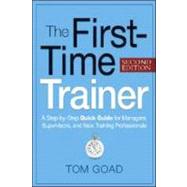
Note: Supplemental materials are not guaranteed with Rental or Used book purchases.
Purchase Benefits
Looking to rent a book? Rent The First-Time Trainer, [ISBN: 9780814415597] for the semester, quarter, and short term or search our site for other textbooks by Goad, Tom W.. Renting a textbook can save you up to 90% from the cost of buying.
TOM W. GOAD (San Diego, CA) has thirty-five years of experience as a trainer and human resources development expert. He is widely published in the HR field, and is the author of the first edition of The First-Time Trainer (978-0-8144-7942-1).
| List of Exhibits | p. v |
| About the Revised Edition | p. viii |
| A Word for the First-Time Trainer | p. ix |
| Introduction | p. 1 |
| The Purpose of This Book | p. 2 |
| About Training | p. 3 |
| Facilitate Learning | p. 7 |
| Step One Summary | p. 10 |
| Skills Trainers Need-Overview | p. 10 |
| The Impact of Diversity and Multigenerational Learners | p. 11 |
| Continuous Learning | p. 12 |
| Trainer Skills | p. 12 |
| The Eight Steps | p. 17 |
| Using the Eight Steps for Various Situations | p. 21 |
| Focus on Performance | p. 24 |
| Step Two Summary | p. 25 |
| Needs Assessment | p. 25 |
| Performance Objectives | p. 44 |
| Focus on Learning | p. 49 |
| Step Three Summary | p. 49 |
| The Learning Process | p. 50 |
| Other Aspects of Learning | p. 59 |
| Building in Success Factors | p. 66 |
| Conclusion | p. 67 |
| Be Prepared | p. 68 |
| Step Four Summary | p. 69 |
| Key Principles of Preparation | p. 71 |
| Making Selections | p. 71 |
| Organizing Training | p. 93 |
| Preparation for Training | p. 100 |
| Pilot Training | p. 104 |
| Deliver Effectively | p. 106 |
| Step Five Summary | p. 106 |
| The Trainer as Communicator | p. 107 |
| How to Give an Effective Presentation | p. 111 |
| Accommodating Diversity and Multiple Generations | p. 126 |
| Conclusion | p. 134 |
| Get Learners Involved | p. 137 |
| Step Six Summary | p. 138 |
| Working with Groups | p. 138 |
| Dealing with Difficult Behaviors | p. 140 |
| Techniques for Getting Learners Involved | p. 145 |
| Get Feedback | p. 159 |
| Step Seven Summary | p. 160 |
| Putting Objectives to the Test | p. 160 |
| Determining What to Measure | p. 161 |
| When and How Much to Evaluate | p. 169 |
| Software Evaluation Tools | p. 169 |
| Improve Continuously | p. 170 |
| Step Eight Summary | p. 171 |
| Training Skills Revisited | p. 171 |
| Strengthening Training Skills | p. 172 |
| The Trainer's Portfolio | p. 174 |
| Technology and Training | p. 176 |
| A Word About Ethics | p. 177 |
| Eight Steps to Effective Training: A Summary | p. 178 |
| Resources for the First-Time Trainer | p. 181 |
| American Society for Training and Development | p. 182 |
| Training Magazine | p. 183 |
| Web Searches | p. 183 |
| Additional Trainer Guidelines | p. 186 |
| Guidelines for How People Learn (Step Three) | p. 187 |
| Guidelines for Dealing with Multiple Generations in the Workplace (Step Five) | p. 191 |
| Guidelines for Evaluating Training (Step Seven) | p. 192 |
| Guidelines for Determining Return on Investment (ROI) (Step Seven) | p. 196 |
| Professional Development Guidelines (Step Seven) | p. 202 |
| Index | p. 207 |
| Table of Contents provided by Ingram. All Rights Reserved. |
The New copy of this book will include any supplemental materials advertised. Please check the title of the book to determine if it should include any access cards, study guides, lab manuals, CDs, etc.
The Used, Rental and eBook copies of this book are not guaranteed to include any supplemental materials. Typically, only the book itself is included. This is true even if the title states it includes any access cards, study guides, lab manuals, CDs, etc.